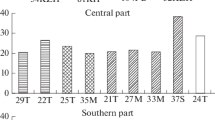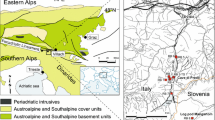Abstract
Rubidium and lithium are rather rare elements in environmental research, despite their affiliation with a group of chemically active metals and the abundance of Rb in the environment. A growing body of evidence, although controversial, has indicated that both elements possess unique essential and neurophysiological characteristics in biota and humans. Both elements may concentrate in soil and vegetation of sub-arid environments. We investigated the content and (potential) availability of Rb and Li in the soils and natural waters of Galilee, the Coastal Plain, and the northern Negev of Israel. A newly developed chromatographic technique for the separation of truly dissolved Rb and Li compounds has been applied. High concentrations of Rb, together with high values of the potentially vital Rb-to-K ratio, were found in the soils, the soil solutions, rainwater, throughfall water, and the plant litter leachates, but not in the surface and spring waters. This may indicate a sequestration of Rb in the local soils and a semi-closed Rb turnover in the soil–plant system with a major input from sea aerosols. Low Li bulk and available concentrations were determined in all the natural compartments. Possible implications of such specific environmental features on the local population health were discussed.


Similar content being viewed by others
References
Anke, M. K., & Angelov, L. (2004). Rubidium. In E. Merian, M. Anke, M. Ihnat, & M. Stoeppler (Eds.), Elements and their compounds in the environment: Occurrence, analysis and biological relevance (2nd ed., pp. 547–563). Weinheim: Wiley-VCH Verlag GmbH & Co. KGaA.
Bowen, H. J. M. (1966). Trace elements in biochemistry. New York: Academic Press.
Bradford, G. R. (1963). Lithium survey of California’s water resources. Soil Science, 96(2), 77–81.
Brown, J. S., Jr. (1994). Role of selenium and other trace elements in the geography of schizophrenia. Schizophrenia Bulletin, 20(2), 387–398.
Carroll, B. J., & Sharp, P. T. (1971). Rubidium and lithium: Opposite effects on amine-mediated excitement. Science, 172(3990), 1355–1357.
Chaudhuri, S., & Clauer, N. (1993). Strontium isotopic compositions and potassium and rubidium contents of formation waters in sedimentary basins: Clues to the origin of the solutes. Geochimica et Cosmochimica Acta, 57(2), 429–437.
Corsini, G. U. (Ed.) (2012). Current trends in lithium and rubidium therapy. In Proceedings of International Symposium on Lithium and rubidium therapy, Venice, 29 September–1st October 1983. Springer.
Dan, J., Yaalon, D. H., Koyumdjisky, H., & Raz, Z. (1976). The soils of Israel: (With Map 1: 500,000). Tel Aviv: Volcani Center, Division of Scientific Publications.
Davey, B. G., & Wheeler, R. C. (1980). Some aspects of the chemistry of lithium in soils. Plant and Soil, 57(1), 49–60.
De Vos, W., Tarvainen, T., Salminen, R., Reeder, S., De Vivo, B., Demetriades, A., et al. (2006). Geochemical atlas of Europe. Part 2. Espoo: Geological Survey of Finland.
Durfor, C. N., & Becker, E. (1964). Public water supplies of the 100 largest cities in the United States, 1962 (No. 1812). US Government Printing Office.
Fieve, R. R., Meltzer, H., Dunner, D. L., Levitt, M., Mendlewicz, J., & Thomas, A. (1973). Rubidium: Biochemical, behavioral, and metabolic studies in humans. American Journal of Psychiatry, 130(1), 55–61.
Gal, M., Amiel, A. J., & Ravikovitch, J. (1974). Clay mineral distribution and origin in the soil types of Israel. Journal of Soil Science, 25, 79–89.
Giotakos, O., Nisianakis, P., Tsouvelas, G., & Giakalou, V. V. (2013). Lithium in the public water supply and suicide mortality in Greece. Biological Trace Element Research, 156(1–3), 376–379.
Heier, K. S., & Billings, G. K. (1970). Rubidium. Handbook of geochemistry (Vol. 2, p. 2). Berlin: Springer.
Herczeg, A. L., & Edmunds, W. M. (2000). Inorganic ions as tracers. In: Environmental tracers in subsurface hydrology (pp. 31–77). Springer: Boston.
Horstman, E. L. (1957). The distribution of lithium, rubidium, and caesium in igneous and sedimentary rocks. Geochimica et Cosmochimica Acta, 12, 1–28.
Kabata-Pendias, A., & Pendias, H. (1984). Trace elements in soil and plants. Boca Raton, FL: CRC Press.
König, D., Baumgartner, J., Blüml, V., Heerlein, A., Téllez, C., Baus, N., et al. (2017). Einfluss von natürlichen Lithiumsalzvorkommen auf die Suizidmortalität in Chile 2000–2009: Eine geographische Analyse. Neuropsychiatrie: Klinik, Diagnostik, Therapie und Rehabilitation, 31, 70–76.
Kot, F. S., Farran, R., Fujiwara, K., Kharitonova, G. V., Kochva, M., Shaviv, A., et al. (2016). On boron turnover in plant–litter–soil system. Geoderma, 268, 139–146.
Kot, F. S., Farran, R., Kochva, M., & Shaviv, A. (2012). Boron in humus and inorganic components of Hamra and Grumosol soils irrigated with reclaimed wastewater. Soil Research, 50(1), 30–43.
Kot, F. S., Fujiwara, K., & Kochva, M. (2017). A simple in situ preconcentration method for the simultaneous determination of major and minor alkali and alkaline-earth metals in natural waters using iminodiacetate-grafted fiber. Analytical and Bioanalytical Chemistry, 409, 3917–3922.
Krulík, R., Farská, I., & Prokeš, J. (1977). Effect of rubidium, lithium and cesium on brain ATPase and protein kinases. Neuropsychobiology, 3(2–3), 129–134.
Liaugaudaite, V., Mickuviene, N., Raskauskiene, N., Naginiene, R., & Sher, L. (2017). Lithium levels in the public drinking water supply and risk of suicide: A pilot study. Journal of Trace Elements in Medicine and Biology, 43, 197–201.
Lieberman, K. W., & Meltzer, H. L. (1970). Recognition of rubidium by the central nervous system. Brain Research, 23(1), 124–127.
Navrot, J., & Singer, A. (1976). Geochemical changes accompanying basic igneous rocks-clay transition in a humid Mediterranean climate. Soil Science, 121(6), 337–345.
Nielsen, F. H. (1998). Knowledge and speculation. The Journal of Trace Elements in Experimental Medicine, 11, 251–274.
Nielsen, F. H. (2012). Other elements: Sb, Ba, B, Br, Cs, Ge, Rb, Ag, Sr, Sn, Ti, Zr, Be, Bi, Ga, Au, In, Nb, Sc, Te, Tl, W. In W. Mertz (Ed.), Trace elements in human and animal nutrition (Vol. 2, pp. 415–463). San Diego: Academic Press.
Paschalis, C., Jenner, F. A., & Lee, C. R. (1978). Effects of rubidium chloride on the course of manic-depressive illness. Journal of the Royal Society of Medicine, 71(5), 343.
Persinger, M. A. (1987). Geopsychology and geopsychopathology: mental processes and disorders associated with geochemical and geophysical factors. Cellular and Molecular Life Sciences, 43(1), 92–104.
Petrini, M., & Azzarà, A. (2012). Lithium in the treatment of neutropenia. Current Opinion in Hematology, 19(1), 52–57.
Ponomareva, V. V., & Plotnikova, T. A. (1980). Humus and soil formation. Leningrad: Nauka. (in Russian).
Preston, C. M., Hempfling, R., Schulten, H.-R., Schnitzer, M., Trofymow, J. A., & Axelson, D. E. (1994). Characterization of organic matter in a forest soil of coastal British Columbia by NMR and pyrolysis-field ionization mass spectrometry. Plant and Soil, 158(1), 69–82.
Ravikovitch, S., Pines, F., & Ben-Yair, M. (1960). Composition of colloids in the soils of Israel. Journal of Soil Science, 11, 82–91.
Relman, A. S. (1956). The physiological behavior of rubidium and cesium in relation to that of potassium. The Yale Journal of Biology and Medicine, 29(3), 248–262.
Ringer, S. (1883). An investigation regarding the action of rubidium and cesium salts compared with the action of potassium salts on the ventricle of the frog’s heart. Journal of Physiology, 4, 370–378.
Sawhney, B. L. (1964). Sorption and fixation of microquantities of cesium by clay minerals: Effect of saturating cations. Soil Science Society of America Journal, 28(2), 183–186.
Schoenfeld, I., & Held, S. (1969). A spectrochemical method for determining rubidium in sea and spring waters. Israel Journal of Chemistry, 7(6), 831–833.
Schrauzer, G. N., & Shrestha, K. P. (1990). Lithium in drinking water and the incidences of crimes, suicides, and arrests related to drug addictions. Biological Trace Element Research, 25(2), 105–113.
Selinus, O., Alloway, B. J., Centeno, J. A., Finkelman, R. B., Fuge, R., Lindh, U., et al. (Eds.). (2013). Essentials of medical geology. New York: Springer.
Shacklette, H. T., & Boerngen, J. G. (1984). Element concentrations in soils and other surficial materials of the conterminous United States. U.S. Geological Survey Professional Paper 1270.
Simonsson, M., Bergholm, J., Lemarchand, D., & Hillier, S. (2016). Mineralogy and biogeochemistry of potassium in the Skogaby experimental forest, southwest Sweden: pools, fluxes and K/Rb ratios in soil and biomass. Biogeochemistry, 131(1–2), 77–102.
Singer, A. (1971). Clay minerals in the soils of the southern Golan Heights. Israel Journal of Earth Sciences, 20, 105–112.
Singer, A. (2007). The soils of Israel. Berlin: Springer.
Souty, N., Guennelon, R., & Rode, C. (1975). Quelques observations sur l’absorption du potassium, du rubidium-86 et du césium-137 par des plantes cultivées sur solutions nutritives. Annales Agronomique, 26, 41–58.
Tessier, A., Campbell, P. G., & Bisson, M. (1979). Sequential extraction procedure for the speciation of particulate trace metals. Analytical Chemistry, 51(7), 844–851.
Turekian, K. K., & Wedepohl, K. H. (1961). Distribution of the elements in some major units of the earth’s crust. Geological Society of America Bulletin, 72(2), 175–192.
Tyler, G., & Olsson, T. (2001). Concentrations of 60 elements in the soil solution as related to the soil acidity. European Journal of Soil Science, 52(1), 151–165.
Üstün, T. B., Ayuso-Mateos, J. L., Chatterji, S., Mathers, C., & Murray, C. J. (2004). Global burden of depressive disorders in the year 2000. British Journal of Psychiatry, 184(5), 386–392.
Vinichuk, M., Taylor, A. F. S., Rosén, K., & Johanson, K. J. (2010). Accumulation of potassium, rubidium and caesium (133 Cs and 137 Cs) in various fractions of soil and fungi in a Swedish forest. Science of the Total Environment, 408(12), 2543–2548.
WHO. (1996). Trace elements in human nutrition and health. Geneva: World Health Organization.
Yaalon, D. H. (1997). Soils in the Mediterranean region: What makes them different? CATENA, 28, 157–169.
Yechieli, Y., Ronen, D., & Vengosh, A. (1997). Isotopic measurements and groundwater dating at the fresh-saline water interface region of the Mediterranean coastal plain aquifer of Israel. Jerusalem: Ministry of National Infrastructures, Geological Survey of Israel.
Zohary, T., Nishri, A., & Sukenik, A. (2012). Present–absent: A chronicle of the dinoflagellate Peridinium gatunense from Lake Kinneret. Hydrobiologia, 698(1), 161–174.
Acknowledgements
I am grateful to Dr. Kunio Fujiwara, Department of Applied Chemistry and Biotechnology, Chiba University, Japan, for methodological help and for supplying us with the IDA-fibre. I am cordially thankful to Prof. Avi Shaviv for his valuable notes and criticism on the manuscript. Dr. Malik Kochva has undertaken many analyses for this work. Both are from the Faculty of Civil and Environmental Engineering, Technion-IIT. Victor Kislovsky from the Faculty of Mechanical Engineering, Technion-IIT assisted me with patience with the fieldwork. I would like to express my sincere gratitude to the anonymous reviewers whose scrupulous work and substantial notes and suggestions brought about improvements to the manuscript. The editing of English was done in Proof-Reading Service, Letchworth, UK. The Technion Research & Development Foundation (Haifa, Israel) and Misrad-haKlita (Jerusalem, Israel) supported the work.
Author information
Authors and Affiliations
Corresponding author
Ethics declarations
Conflict of interest
The author declares no competing financial interest.
Rights and permissions
About this article
Cite this article
Kot, F.S. On the rubidium and lithium content and availability in the sub-arid south-eastern Mediterranean: potential health implications. Environ Geochem Health 40, 1841–1851 (2018). https://doi.org/10.1007/s10653-018-0134-8
Received:
Accepted:
Published:
Issue Date:
DOI: https://doi.org/10.1007/s10653-018-0134-8




